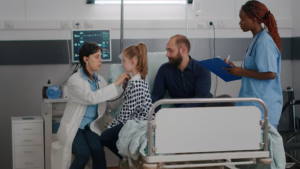Clinical Laboratory In Allied Health: What You Need To Know
Coming up with life-saving diagnoses, groundbreaking medical discoveries, and personalized treatment plans, all of which is possible with a team of unsung heroes working in the labs, Clinical Laboratory Scientists (CLS). Also known as medical laboratory scientists or clinical lab technologists, these professionals are the backbone of modern healthcare.
They test blood, tissue, and bodily fluids to diagnose diseases, monitor treatments, and give vital information that drives patient care. However, as technology advances and healthcare needs increase, the role of the clinical laboratory scientist is changing in ways that are likely to reshape their impact on global health.
Let’s look at the future of this critical profession, the challenges it faces, and the innovations that will drive it forward.
The Pillars of Healthcare
Clinical laboratory scientists are the detectives of medical science. When a doctor orders a test — say, a routine cholesterol screening or a complex genetic analysis — CLS professionals are the ones who ensure that the tests are carried out accurately, interpret the results, and alert the physician if anything looks abnormal.
The World Health Organization (WHO) reports that as much as 70% of medical decisions depend on laboratory test results, highlighting how critical these experts are to patient outcomes.
CLS professionals play a crucial role in the process, yet most of them toil away behind the scenes. “We are the invisible side of healthcare,” says Dr. Emily Torres, a clinical lab scientist with 15 years of experience. “But without accurate lab data, doctors are pretty much flying blind.”
Are you a Phlebotomist? The Trends That Shape the Future of Clinical Laboratory Science
Trends Shaping the Future of Clinical Laboratory Science
1. Automation and Artificial Intelligence
Labs are undergoing a revolution thanks to automation. Now, robotic systems handle repetitive tasks such as pipetting and sorting samples, reducing human error and expediting workflows. At the same time, artificial intelligence (AI) is improving diagnostic accuracy.
Machine learning algorithms are capable of sifting through large amounts of data—including pathology slides or genomic sequences—to find correlations that the human eye may not. AI tools, for instance, have been found in some studies to detect early-stage cancers with 95 percent accuracy, a huge step forward compared to traditional methods.
But automation does not mean the death of human expertise. Instead, it’s allowing CLS professionals to spend time on complex analyses, research, and interdisciplinary collaboration. “The lab of the future combines cutting-edge tech with human intuition,” says Dr. Raj Patel, a laboratory director in Chicago. “CLS teams will evolve into solutions providers — not just technicians.”
2. Personalized Medicine and Genomics
The growth of personalized medicine — customizing treatments for a patient’s genetic makeup — is opening new frontiers for CLS professionals. Genomic testing, which was once a niche field, has become mainstream.
The labs are increasingly being asked to sequence DNA, identify mutations associated with diseases like cancer, and inform therapies guided by biomarkers. The global genomics market is expected to grow to $ 94 billion by 2030, fueled by the need for precision diagnostics.
CLS professionals must possess advanced molecular techniques themselves, so they are ahead of the curve as science evolves at such a rapid pace. “We’re no longer just testing; we’re reading the blueprint of life,” says Maria Gonzalez, a molecular biology expert.
3. Telehealth and Decentralized Testing
The COVID-19 pandemic spurred the rapid adoption of telehealth, and its aftershocks are reaching labs. Patients are now demanding rapid, convenient access to testing.
Portable devices — such as handheld blood analyzers and at-home P.C.R. kits — are moving lab work out of centralized facilities, allowing tests to be performed in pharmacies, clinics, or even patients’ homes.
This trend is alleviating delays in overcrowded hospitals, but it is also raising questions about quality control. CLS professionals will be integral to standardizing decentralized testing and ensuring results yield high clinical performance standards.
Challenges on the Horizon
While the future is bright, the profession faces hurdles that demand urgent attention:
Workforce Shortages
Clinical laboratory jobs are expected to grow 7% by 2031, according to the U.S. Bureau of Labor Statistics, but filling those roles won’t be simple. There are aging workforces retiring, and it’s difficult for universities to find students to take CLS programs. More importantly, 30% of lab professionals report being burnt out due to understaffing and overwhelming workloads.
“We’re at a crossroads,” said Dr. Linda Carter, president of the American Society for Clinical Laboratory Science. “We could be facing a crisis in which patient care across the country is impacted if we don’t invest in education and retention.”
Regulatory and Ethical Complexity
Ethical dilemmas arise as genetic testing and AI are adopted by labs. Who owns genomic data? How can we avoid algorithmic bias in diagnostics? CLS personnel will have to address these matters while complying with continually evolving rules.
Opportunities for Innovation
Expanding Roles in Public Health
In public health, CLS professionals are coming forward. During the pandemic, they created COVID-19 tests, tracked variants, and improved testing protocols. Their expertise will also be key to addressing problems such as antimicrobial resistance, emerging viruses, and chronic diseases.
Interdisciplinary Collaboration
The future lab will be highly integrated with other healthcare teams. CLS professionals are teaming up with bioengineers to create lab-on-a-chip devices, with data scientists to develop predictive models, and with policymakers to inform public health initiatives.
Advocacy and Visibility
Professional organizations are working to publicize the CLS field. Social media campaigns, scholarships, and mentorship programs are all such efforts to woo a new generation. “It’s not just a job; it’s a career that saves lives, and we need to show students that,” Torres says.
Preparing for Tomorrow: Education and Technology
CLS training programs are changing with the times to stay competitive. Now, curricula include bioinformatics, AI literacy, and leadership skills. Virtual reality (VR) simulations enable students to practice techniques without risk, and online certifications increase opportunities for specialized training, too.
At the same time, labs are investing in sustainability. Efforts to curb the environmental footprint of lab operations — a top priority for younger professionals — are underway, with energy-efficient equipment and waste-reduction initiatives.
A Profession Poised for Transformation
Clinical laboratory scientists have always been critical, but their role is expanding in never-before-seen ways. From harnessing AI to enhancing personalized medicine, they’re poised to fuel healthcare innovation for years to come. But fulfilling this potential will require tackling workforce shortages, updating education, and promoting the value of the profession.
As Dr. Patel puts it: “No question, the future of health care isn’t only in the exam room or the operating room — it’s in the lab. For both patients and providers, that future looks a lot brighter with clinical laboratory scientists in the lead.
Check out these other great Staffdna articles

Hospitalist Jobs vs. General Physician Assistant Jobs: What’s the Difference?
When medical professionals are considering their career options, the first things that come to mind are either hospitalists or general physician assistants.

Busting Myths About PRN Nursing Jobs: Pros, Cons & How to Find the Best Shifts
PRN nursing jobs have become a favorite among medical professionals looking for flexibility and higher pay. Yet, many misconceptions exist about PRN positions that scare some nurses away from considering it as a career choice.

How to Handle the Pressure of PACU Nursing Jobs Without Burning Out
Nursing is a demanding field, which becomes even more challenging when it comes to PACU nursing jobs.

How to Transition from Staff Nurse to A Travel Nurse
If you are a Registered Nurse with a strong desire to travel to different locations and save lives, you can be a travel nurse.

Travel Nursing: How to Choose the Best Career Assignments
Travel nursing is one way for nurses to work through new locations while also building their skill sets.

Understanding the PICU: A Guide for PICU Nurses
The pediatric intensive care unit (PICU) is a specialized department in hospitals and medical facilities. It is made to provide intensive care to infants, children, and adolescents with severe medical conditions.
